Sildalist
Generic 120 mg sildalist with visa
Dry-warmth sterilizers (ovens) are good in humid climates but need a steady provide of electricity erectile dysfunction medication new zealand sildalist 120mg on line, making them impractical in many remote (rural) areas. Standard Conditions for Heat Sterilization Steam sterilization (Gravity): Temperature ought to be 121qC (250qF); 2 pressure ought to be 106 kPa (15 lbs/in); 20 minutes for unwrapped objects; half-hour for wrapped objects. Or at the next temperature of 132qC (270qF), 2 pressure ought to be 30lbs/in; 15 minutes for wrapped objects. Note: High-pace (flash) prevacuum sterilizers are Allow all objects to dry earlier than removing them from the sterilizer. Sterilizing time for unwrapped devices by Dry warmth: this technique is shorter, only taking four minutes. Flash x 170qC (340qF) for 1 hour (whole cycle time�inserting devices in sterilization is often used oven, heating to 170qC, timing for 1 hour, and then cooling�is from 2� for individual objects. Remember: x Exposure time begins only after the sterilizer has reached the target temperature. The material used for wrapping devices and different objects should be porous enough to let steam by way of but tightly woven enough to shield towards dust particles and microorganisms (see Appendix G for wrapping and packaging instructions). Wrapped sterile packs should stay sterile till some occasion causes the package deal or container to turn into contaminated. An occasion can be a tear or worn area within the wrapping, the package deal becoming wet or anything that may enable microorganisms to enter the package deal or container. They happen in animals (dogs, cows and primates) as well as humans and are rapidly deadly as soon as signs develop. Therefore, surgical devices and different crucial devices contaminated with high-danger tissue. Infection Prevention Guidelines eleven three Sterilization x Following surgical procedure, noncritical objects such as the working desk, Mayo stand and different environmental surfaces may be decontaminated Note: Do not soak by wiping with a cloth soaked with zero. It is many instances more effective in conveying this sort of energy to the item than is scorching (dry) air. In a kitchen, potatoes may be cooked in a few minutes in a steam pressure cooker while cooking may take an hour or extra in a scorching-air oven, although the oven is operated at a much greater temperature. Steam, especially underneath pressure, carries thermal energy to the potatoes very quickly, while scorching air does so very slowly. Second, steam is an efficient sterilant because any resistant, protective outer layer of the microorganisms may be softened by the steam, allowing coagulation (similar to cooking an egg white) of the delicate inner portions of the microorganism. Certain types of contaminants, nonetheless, especially greasy or oily materials, can shield microorganisms towards the effects of steam, thus hindering the process of sterilization. This re emphasizes the necessity for thorough cleansing of objects earlier than sterilization. Requirements Steam sterilization requires four conditions: enough contact, sufficiently high temperature, right time and adequate moisture. Although all are necessary for sterilization to happen, sterilization failures in clinics and hospitals are most often attributable to lack of steam contact or failure to attain enough temperature. All four conditions are mentioned, in order of their significance in ensuring full sterilization by steam, in Appendix G. Disadvantages x Requires a steady source of heat (wood gas, kerosene or electricity). If using a pressure cooker or kerosene-powered (nonelectric) gravity displacement steam sterilizer, deliver the water to a boil and let steam escape from the pressure valve; then turn down warmth, but maintain steam popping out of the pressure valve. Allow instrument packs to dry fully earlier than removal, which can take up to half-hour. Unwrapped objects should be used immediately or saved in lined, sterile containers. Ideally, a steam sterilizer log ought to be saved, noting time: x warmth begun, x right temperature and pressure achieved, x warmth turned down, and x warmth turned off. Keeping a log might help make sure that the required period of time might be noticed, even when multiple, new or hurried staff are responsible for overseeing sterilization. A convection oven with an insulated stainless-steel chamber and perforated shelving to enable the circulation of scorching air is beneficial, but dry-warmth sterilization may be achieved with a easy oven so long as a thermometer is used to verify the temperature inside the oven.
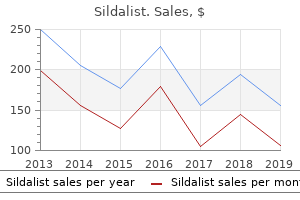
Generic 120 mg sildalist with mastercard
Itraconazole (6�10 mg/kg erectile dysfunction in the age of viagra purchase sildalist online now, up to a maximum of 400 mg, orally, day by day) is the drug of alternative for chil dren with lymphocutaneous and localized cutaneous illness. The length of therapy is 2 to 4 weeks after all lesions have resolved, usually for a total length of three to 6 months. Alternative therapies embody saturated solution of potassium iodide (1 drop, three instances day by day, growing as tolerated to a maximum of 1 drop/kg of body weight or forty to 50 drops, three instances day by day, whichever is lowest). After scientific response to amphotericin B therapy is documented, itraconazole could be substituted and ought to be continued for a minimum of 12 months. Serum concentrations of itraconazole ought to be measured after a minimum of 2 weeks of therapy to ensure adequate drug exposure. Surgical debridement or exci sion may be necessary to resolve cavitary pulmonary illness. Clinical apply guidelines for the management of sporotrichosis: 2007 update by the Infectious Diseases Society of America. The brief incubation interval, brevity of sickness, and traditional lack of fever help distinguish staphylococcal from other forms of meals poisoning except that brought on by Bacillus cereus. Chemical meals poisoning usually has a shorter incubation interval, and Clostridium perfringens meals poisoning usually has an extended incubation interval. Patients with foodborne Salmonella or Shigella an infection usually have fever and an extended incubation interval (see Appendix X, Clinical Syndromes Associated With Foodborne Diseases, p 921). Foods usually implicated are people who come in contact with arms of meals han dlers without meals subsequently being cooked or meals which might be heated or refrigerated inadequately, similar to pastries, custards, salad dressings, sandwiches, poultry, sliced meats, and meat products. When these meals stay at room temperature for a number of hours, toxin-producing staphylococci multiply and produce heat-stable toxin within the meals. The organisms could be of human origin from purulent discharges of an infected fnger or eye, abscesses, acneiform facial eruptions, nasopharyngeal secretions, or apparently normal pores and skin. Less commonly, enterotoxins could be of bovine origin, similar to contaminated milk or milk products, particularly cheese. Bacteremia could be sophisticated by septicemia; endocar ditis; pericarditis; pneumonia; pleural empyema; soft tissue, muscle, or visceral abscesses; arthritis; osteomyelitis; septic thrombophlebitis of small and enormous vessels; and other foci of an infection. Primary S aureus pneumonia also can occur after aspiration of organisms from the upper respiratory tract and sometimes is related to mechanical ventilation or viral infections in the community (eg, infuenza). Risk factors for severe S aureus infec tions embody continual illnesses, similar to diabetes mellitus and cirrhosis, immunodefciency, dietary issues, surgical procedure, and transplantation. Staphylococcus aureus Toxic Shock Syndrome: Clinical Case Defnitiona Clinical Findings � Fever: temperature 38. Renal: serum urea nitrogen or serum creatinine focus higher than twice the upper limit of normal or urinary sediment with 5 white blood cells/excessive-energy feld or higher within the absence of urinary tract an infection 5. Hepatic: complete bilirubin, aspartate transaminase, or alanine transaminase focus higher than twice the upper limit of normal 6. Staphylococci are ubiquitous and may survive extreme conditions of drying, heat, and low-oxygen and excessive-salt environments. This permits a low inoculum of organisms to adhere to sutures, catheters, prosthetic valves, and other devices. S aureus colonizes the pores and skin and mucous membranes of 30% to 50% of healthy adults and children. Rates of carriage of more than 50% occur in children with desquamating pores and skin issues or burns and in people with frequent needle use (eg, diabetes mellitus, hemodialysis, illicit drug use, allergy pictures). S aureus is transmitted most often by direct contact in com munity settings and indirectly from patient to patient by way of transiently colonized arms of well being care professionals in well being care settings. Contaminated environmental surfaces and objects also can play a task in transmission of S aureus, though their contribution to spread in all probability is minor. Heavy cutaneous colonization at an insertion website is the only most essential predictor of intravenous catheter-associated infections for brief-term percutaneously inserted cath eters. For hemodialysis sufferers with S aureus pores and skin colonization, the incidence of central line-related bloodstream an infection is sixfold greater than for sufferers without pores and skin colo nization. A concern is that the majority automated antimicrobial suscep tibility testing methods commonly used within the United States had been unable to detect van comycin resistance in these isolates. For central line-association bloodstream an infection, quantitative blood cultures from the catheter will have 5 to 10 instances extra organisms than cultures from a peripheral blood vessel.
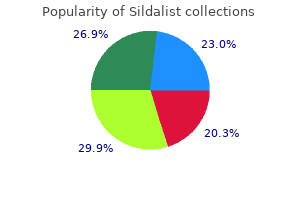
Generic sildalist 120 mg without a prescription
Determine which tubes are unlabeled how do erectile dysfunction pills work order sildalist 120mgmg without prescription, and credit the checks comparable to the unlabeled tubes(s). Occasionally, a number of labeled tubes could also be packaged with the unlabeled specimen, and these labeled tubes can be processed for testing. Place the massive barcode label on the Reference Lab requisition with a comment stating that the specimen was unlabeled. These specimens would be accessioned based on the name and examined so long as they might be paired with their authentic requisitions. If the client insists that the specimen be examined, a specimen launch form is required via fax or courier from the client stating that they take duty for the outcomes from an unlabeled specimen. Never accession an unlabeled specimen with the alleged patient�s name, birth date, social security number or the chart number. Finally, all requests for testing on unlabeled specimens must be reviewed prior to testing by a supervisor or lead tech. These cost personnel must verify that the test requested is a screening test and never a diagnostic test. Page 2 of 2 Carolinas Laboratory Network Carolinas Medical Center Unlabeled Specimen Release Form I (please print name) request that Carolinas Medical Center Laboratory perform the following test(s) on an unlabeled specimen obtained from my facility. Critical values are these abnormal test outcomes that would potentially be life threatening. Critical checks are these recognized checks that require speedy communication of outcomes, even when outcomes are regular. All crucial values must be called immediately and all crucial checks must be called within timeframe famous on crucial test record. Results are called by the reporting laboratory on to a medical professional in the facility related to the patient or client. If that medical professional is unavailable, you must then request the cost nurse of that location. See item #four below for particular directions on microbiology crucial values for the emergency department. During common enterprise hours of a client facility, notification attempts continue to occur until profitable. Discharged Patients 9am � 5pm All crucial values are reported on to Rozella Bethea at 704-355-0506 or pager # 4309. All Other Times Microbiology crucial values must be called to an attending emergency medication physician immediately. For pediatrics (ages 0-17), contact Pediatric Emergency Medicine Attending at 355-6580. Failed attempts for checks resulted in Sunquest must be documented as famous above and critical checks which are resulted in CoPath must be documented in the report. Results held to the following enterprise day ought to embody the date the result was called. Reading Back Critical Values All crucial values and checks reported to a medical professional verbally or by telephone must be �read-back� by the medical professional receiving the knowledge. Documentation in Sunquest of a �read-back� must be included with other required contact/notification data. Critical Tests Critical checks are defined and handled in the same method as crucial values. The compliance of crucial checks notification is reported monthly to the Patient Safety Steering committee. Patients must be properly ready in order that the absolute best specimen can be collected. Care, ability, and knowledge when preparing the patient and specimen are important to the provision of the best quality requirements for testing and providers. Healthcare personnel are required to comply with suggestions, which allow the safety of each the patient and healthcare personnel. Patient Preparation Many checks require that the patient be ready in some specific way to ensure useful outcomes.
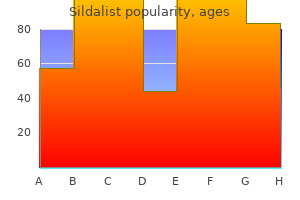
Order 120 mg sildalist mastercard
Free trioses go into a condensation reaction easier than their phosphate esters impotent rage violet sildalist 120mg line, therefore the shaped phosphotrioses first endure fundamental hydrolysis to disconnect the phosphate. As a result of triose condensation reaction with 2,four-dinitrophenylhydrazine, the appropriate 2,four-dinitrophenylhydrazones type. In order to inhibit glyceraldehyde 3-phosphate dehydrogenase present within the tissues, which can oxidize the shaped glyceraldehyde 3-phosphate to 1,3-bisphosphoglycerate, monoiodoacetic acid is utilized. This is particularly important when inspecting the aldolase reaction in tissue homogenates, the place (as opposed to blood serum) each of those enzymes (aldolase and glyceraldehyde 3-phosphate dehydrogenase) happen facet by facet. The presence of hydrazine in the course of the incubation of the substrate with aldolase shifts the stability of the reversible enzymatic reaction within the path of phosphotrioses creation. Compare the intensity of the color in the true checks with the corresponding management trials. Present the leads to the Table, evaluating the intensity of coloration with three, two or one plus indicators. You can even determine the quantity of the shaped trioses using the colorimetric method, by measuring the absorbance of sunshine at wavelength 570 nm compared to the management. Muscle extract Blood serum Control check Real checks Control check Real checks (check tube 1) (check tubes 2 & 3) (check tube four) (check tubes 5 & 6) 0. Most of the pyruvate is transformed within the mitochondrial matrix to acetyl-CoA within the means of oxidative decarboxylation, catalyzed by the multienzymatic complicated known as pyruvate dehydrogenase. This complicated is made up of pyruvate decarboxylase (E1), dihydrolipoyl transacetylase (E2) and dihydrolipoyl dehydrogenase (E3). The obtained acetaldehyde, coupled with the tiasolic ring of thiamine pyrophosphate, is separated within the second stage with simultaneous oxidation (disconnecting the pair of hydrogens). The acetic acid residue joins by extremely energetic binding (thioester) to the sulphur atom of lipoate. The hydrogen atoms from aldehyde are transferred to thiamine and the second sulphur atom of lipoate. The object of the train is to demonstrate the consumption of pyruvate added to the homogenate of rat liver. This complicated immediately oxidizes acetaldehyde (bound with the thiazole ring of thiamine pyrophosphate) into acetic acid. The reaction is interrupted by adding trichloroacetic acid, and also you evaluate the consumption of pyruvate by the use of a color reaction. In 2 the circumstances of our experiment, it inhibits the reaction catalyzed by dihydrolipoyl dehydrogenase. You asses the content of pyruvate within the reacting system by the use of the reaction with 2,four-dinitrophenylhydrazine. All -keto acids, and therefore pyruvate, react with 2,four-dinitrophenylhydrazine to type the corresponding phenylhydrazones. After adding ethyl acetate and vigorously shaking, the combination separates into layers. In the aqueous section (decrease layer), water and salts contained within the tissue extracts stay. In the organic section (higher layer), phenylhydrazones and excess of two,four dinitrophenylhydrazine accumulate. While shaking, the phenylhydrazones transit into the aqueous section, which contains sodium carbonate (bottom layer), and free 2,four-dinitrophenylhydrazine remains within the organic section of ethyl acetate (higher layer). The colour intensity is proportional to the concentration of pyruvate within the reacting system. Incubation To six numbered check tubes (1-6) add the appropriate amounts of reagents, based on Table I. Add 2 ml of rat liver homogenate to every check tube and incubate in a water tub at 37�C for 45 minutes. Filter the contents of all check tubes through small filters made from filter paper to the next sequence of short check tubes. Then, add four ml of ethyl acetate and mix vigorously for 1 minute using an acceptable pipette (repeate aspirate�release cycles). Based on colour differences, assess by which check tube pyruvate consumption occurred. In formulating observations, use the symbols: (+) consumption, (-) lack of consumption.
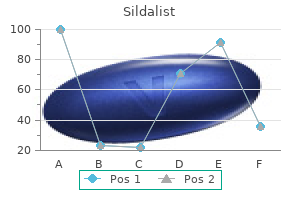
Generic 120mgmg sildalist
The subxiphoid view can be used for this willpower erectile dysfunction and age cheap sildalist 120mg online, however the left ventricle is farther away from the probe on this view. Strong ventricular contractility (usually termed hyperdynamic, due to the strength of contractions of the left ventricle in addition to a rapid heart price) is commonly seen in early sepsis and in hypovolemic shock. Bedside echocardiography also allows for repeated analysis of the patient�s heart, in search of modifications in contractility over time, particularly when if a patient�s standing dete riorates. For instance, later in the middle of sepsis there could also be a decrease in contrac tility of the left ventricle because of myocardial depression. This data will function a critical guide for the clinician to determine the amount of fluid that may be safely given to a patient. As an instance, in a heart with poor contractility, the threshold for initiation of vaso pressor brokers for hemodynamic support ought to be decrease. In contrast, sepsis sufferers have been shown to benefit with aggressive early aim-directed therapy, beginning with massive amounts of fluids earlier than use of vasopressor medicines. In cardiac arrest, the clinician ought to specifically look at for the presence or absence of cardiac contractions. If contractions are seen, the clinician ought to search for the coordinated movements of the mitral and aortic valves. In this scenario, the absence of coordinated opening of mitral and aortic valves will require chest compres sions to keep cardiac output. This side is predominantly a cause of the muscular hypertrophy that takes place in the myocar dium of the left ventricle after birth, with the closure of the ductus arteriosus. The left ventricle is under considerably more stress than the proper ventricle, to meet the demands of the higher systemic stress, and hypertrophy is a normal compensatory mechanism. On bedside echocardiography, the conventional ratio of the left to right ventricle is 1:0. Any situation that causes stress to abruptly enhance within the pulmonary vascular circuit will end in acute dilation of the proper heart in an effort to keep ahead circulate into the pulmonary artery. The traditional cause of acute right heart strain is a large central pulmonary embolus. Due to the sudden obstruction of the pulmonary outflow tract by a large pulmonary embolus, the proper ventricle will attempt to compen sate with acute dilation. Previous revealed research have looked at the sensitivity of the discovering of right heart dilation in helping the clinician to diagnose a pulmonary embolus. The outcomes present that the sensitivity is average, however the specificity and positive predictive value of this discovering are high in the right scientific scenario, particularly if hypotension is current. The literature means that normally, sufferers with a pulmonary embolus ought to be instantly began on heparin. However, a hypotensive patient with a pulmonary embolus ought to be thought-about for thrombolysis. The aorta will usually come shortly into view from this plane as a thicker walled and deeper structure. This respiratory variation could be further augmented by having the patient sniff or encourage forcefully. As with visible analysis of the jugular veins, the patient�s head is positioned at a 30 angle. Using a high-frequency linear array transducer, the internal jugular veins can first be found in the short-axis plane, then evaluated more closely by moving the probe into a long-axis configuration. The location of the superior closing meniscus is set by the purpose at which the partitions of the vein touch one another. In traumatic circumstances, the clinician must shortly determine whether or not hemoperitoneum or hemothorax is current, on account of a ��gap in the tank,�� leading to hypovolemic shock. In nontrau matic circumstances, accumulation of excess fluid into the belly and chest cavities usually signifies ��tank overload,�� with resultant pleural effusions and ascites that will construct-up with failure of the center, kidneys, and/or liver. However, many sufferers with intrathoracic or intra-belly fluid collections are literally intravascularly volume depleted, complicated the scientific image. In infectious states, pneumonia could also be accom panied by a complicating parapneumonic pleural effusion, and ascites might result in spontaneous bacterial peritonitis. Depending on the scientific scenario, small fluid collections within the peritoneal cavity may characterize intra-belly abscesses leading to a sepsis image. The peritoneal cavity could be readily evaluated with bedside ultrasound for the pres ence of an abnormal fluid collection in each trauma and nontrauma states.
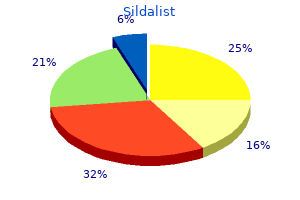
120 mg sildalist amex
The process may be performed with the affected person lying on their facet with the affected facet uppermost best erectile dysfunction vacuum pump buy generic sildalist 120mgmg on line. In trauma conditions emergency drain insertion is more prone to be performed while the affected person continues to be in supine place as a part of the primary trauma survey. Premedication/local anaesthetic Chest drain insertion has been reported to be a painful process with 50% of patients experiencing ache levels of 9-10 on a scale of 10 in one study (Luketich, 1998) subsequently analgesia must be thought-about. Cleaning the skin with an antiseptic solution and adequate use of local infiltration of local anaesthetic (as much as 3mg/kg of Lignocaine) allowing sufficient time to work is essential. If sedation techniques are being used, the process must be performed with acceptable monitoring and resuscitation gear instantly available. Chest drain tubes Chest drains are available in a range of sizes suitable for quite a lot of purposes (usually 10-36Ch) and may be inserted via an open surgical incision (thoracostomy) or using the Seldinger approach incorporating a information wire and dilator system. Inserting the drain the place of the drain is set by the placement and the character of the th collection to be drained. The 5 intercostal space within the mid-axillary line is generally used for many conditions. This space is often known as the �secure triangle�, bordered by the anterior border of latissimus dorsi, the lateral border of the pectoralis major, a line superior to the horizontal level of the nipple and an apex below the axilla. If massive bore chest drains are to be positioned within the pleural cavity; vital pressure should never be used as this risks sudden chest penetration and injury to essential intra-thoracic constructions. Open incision with blunt dissection of deep tissues with forceps or introducer-guided insertion of the drain is the preferred approach. The operator should ensure managed spreading of the intercostal muscle tissue on the superior surface of the ribs to avoid injury to the intercostal vessels and nerves that run below the inferior border of the ribs. All drain holes have to be within the pleural cavity for the drainage system to work effectively. If drain holes are situated inside the subcutaneous tissues, air or fluid could escape into the tissues and cause surgical emphysema or collections of potentially infected fluid. Surgical emphysema is the irregular presence of air inside the subcutaneous tissues. If neither is the case, then this means that the drainage system is insufficient to cope with the degree of air leak. The degree of drainage could be elevated by making use of suction, inserting a second drain or a bigger bore tube. The drainage system Once the drain is sufficiently inserted it must be connected to an acceptable closed drainage system decided by the clinical indication for insertion. Passive drainage system that is an underwater seal drainage system which employs optimistic expiratory stress and gravity to drain the pleural space. The drainage tube is submerged to a depth of 2cm within the water of the reservoir / collection chamber*. This ensures minimum resistance to drainage of air and maintains the underwater seal even within the face of a big inspiratory effort. The underwater seal acts as a one-means valve through which air is expelled from the pleural space and is prevented from re-getting into through the next inspiration. Retrograde flow of fluid could happen if the collection chamber is raised above the level of the affected person. The collection chamber must be kept below the level of the affected person always to prevent fluid being siphoned back into the pleural space. If the underwater seal fails then air easily passes back up the tube during inspiration and the lung will collapse. Drainage could be allowed to happen beneath gravity or suction may be utilized (see section 7). Portable valve systems these must be used for patients with on-going air leaks or fluid drainage. These are based on a one-means flutter system which theoretically may be advantageous as resistance to airflow is generally decrease than with conventional underwater seal models. This is a �no water� ambulatory bag system which incorporates a one way valve and can be used within the hospital environment or at home for patients requiring long run pleural drainage. The speedy shift in pleural pressures and re-growth of the previously collapsed lung can cause re-growth pulmonary oedema, a potentially fatal complication.
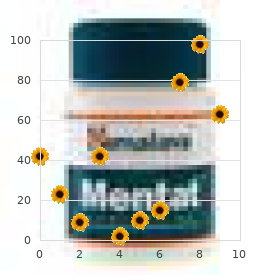
Discount sildalist 120mg otc
Prevent additional warmth loss by eradicating the patient from the setting and eradicating wet garments and drying skin erectile dysfunction doctor houston cheap 120 mg sildalist with amex, insulate from the ground, shelter the patient from wind and wet situations, and insulate the patient with dry clothing or a hypothermia wrap/ blanket. Cover the patient with a vapor barrier and, if out there, transfer the patient to a warm setting d. Initiate area-rewarming methods similar to placement of huge warmth packs or warmth blankets (chemical or electrical if feasible) to the anterior chest or wrapped around the patient�s thorax if large enough i. Chemical or electrical warmth sources should by no means be applied on to the skin ii. Attempt to hold the patient in the horizontal position, especially limiting movement of the extremities to avoid growing return of chilly blood to the center ii. Once in a warm setting, clothing ought to be minimize off (rather than eliminated by manipulating the extremities) 300 iii. Move the patient only when needed similar to to take away the patient from the elements f. If the patient has proof of frostbite, and ambulation/journey is critical for evacuation or security, avoid rewarming of extremities till definitive therapy is possible. Additive harm occurs when the world of frostbite is rewarmed then inadvertently refrozen. If rewarming is feasible and refreezing may be prevented use circulating warm water (37 39�C /ninety eight. Given the additive results of further chilly stress, the patient ought to be removed from the chilly setting as soon as operationally feasible 2. Available proof means that warmth packs with peak temperatures above 45�C (113�F) are most likely to trigger burns. The following are contraindications for initiation of resuscitation in the hypothermic patient: a. The patient displays indicators of being frozen (similar to ice formation in the airway) c. Avalanche victims buried for 35 minutes or longer with airway obstruction by ice or snow 2. Fixed and dilated pupils, apparent rigor mortis, and dependent lividity may not be contraindication for resuscitation in the severely hypothermic patient 3. The mainstay of remedy in extreme hypothermia and cardiac arrest ought to be efficient chest compressions and attempts at rewarming Chest compressions ought to be provided on the identical fee as in normothermic sufferers 4. The temperature at which defibrillation should first be tried in the severely hypothermic cardiac arrest victim and the number of defibrillation attempts is unclear. There are completely different approaches regarding resuscitation of the hypothermic arrest patient. The state of Alaska�s 2014 steerage on management of hypothermic sufferers in cardiac arrest advises that defibrillation ought to be tried as soon as, adopted by 2 minutes of chest compressions, then rhythm and pulse checks i. An alternate technique, per the Wilderness Medical Society�s unintentional hypothermia guideline, means that if the patient�s core temperature is beneath 30�C (86�F), try defibrillation as soon as, then wait till the patient has been rewarmed no less than 1� 2�C or to 30�C (86�F) before attempting further shocks. It is noted that the probability of successful defibrillation will increase with every one-degree improve in temperature d. If defibrillation is unsuccessful and the patient�s core temperature is larger than 30�C (86�F), observe tips for normothermic sufferers. Manage the airway per normal care in cardiac arrest victims [see Cardiac Arrest guideline] a. In the absence of superior airways, ventilate the patient on the identical fee as a normothermic patient b. If the patient has a sophisticated airway, ventilate at half the speed really helpful for a normothermic patient to stop hyperventilation. Measure of sufferers who acquired therapy to correct their hypoglycemia o Trauma-01: Pain assessment of injured sufferers. Recognizing that ache is undertreated in injured sufferers, you will need to assess whether a patient is experiencing ache 303 References 1. Wilderness Medical Society tips for the prevention and therapy of frostbite. Wilderness Medical Society apply tips for the prevention and therapy of frostbite: 2014 update. Pennsylvania Statewide Advanced Life Support Protocols: Hypothermia/chilly harm/frostbite.
Order sildalist with paypal
Small burns could be estimated by consider ing the area of the closed palm of the patient�s hand to erectile dysfunction drugs research best purchase for sildalist represent 1 per cent. One-half of the amount is administered in the rst 8 h following the burn and the rest over the following sixteen h. There are two approaches: Left anterolateral approach via the fth intercostal space Clam procedure � an extension of a one-sided thoracotomy across the mid-line and into the same intercostal space on the other facet. Dysfunction 187 If the center has been injured, then a pericardial tamponade may be obvious, which might want to be evacuated. Cross-clamping the descending aorta requires the left lung to be lifted anteriorly and collapsed down. The mediastinal pleura should be dissected from the surface of the aorta, and a window must be made with blunt dissection behind the aorta where it rests on the vertebral column. Four views are utilised: Perihepatic space Perisplenic space Pelvis Pericardium. Venous reduce-down this procedure is of worth if percutaneous makes an attempt at cannulation have failed. The most common website for a reduce-down is the good saphenous vein simply above the medial malleolus. Diagnostic peritoneal lavage this procedure involves inserting a peritoneal dialysis catheter into the peritoneal cavity as soon as the abdomen and bladder have been decompressed with a catheter and gastric tube respectively. The test is positive if laboratory evaluation indicates more than one hundred 000 purple blood cells per cubic millimetre, or more than 500 white blood cells per cubic millimetre. Complications of this procedure include haemorrhage, peritonitis, harm to intra-belly buildings, and wound infection. Pupils should be assessed for the following: Size: � Small � consider opioids, brainstem harm � Large � consider hypoxia, hypothermia, medicine (adrenaline, atropine, barbiturates), postictal state. This may be delayed if the patient has to have a important intervention to maintain the airway, respiratory or circulation. This detailed analysis requires the patient to be exposed and examined from head to toe and from entrance to again while sustaining normothermia. All clothing, particularly if moist, must be eliminated, and debris around the patient similar to broken glass or soil must be cleared. If the patient has arrived on a protracted board, it is important to log-roll the patient off the board as quickly as virtually attainable in order to prevent strain sores. At the same time, an examination of the backbone and a rectal examination could be carried out. All clothing eliminated should be kept to one facet, as they may be required for forensic examination by the police. The patient can also be transferred out of the receiving hospital to a tertiary centre for ongoing management. The patient should be monitored totally, and applicable resuscitation tools should be out there throughout the transfer. The transfer staff should be totally skilled and able to performing additional resuscitation if essential. If the patient must go to theatre before a radical secondary survey, this survey should be carried out as quickly as is virtually attainable. This is because of the complexity of the accidents and the truth that certain specialist care is probably not out there instantly on website. The circumstances surrounding the accidents may be topic to police investigation. Repeat examinations, ideally by the same clinician, do the patient no hurt and may spotlight a slowly evolving pathology. It should by no means be assumed that a head-injured patient is drunk; somewhat, assume that the intoxicated patient has a head harm and wishes additional investigation. Human albumin resolution for resuscitation and quantity expan sion in critically sick patients. Approximately 15 per cent of all trauma patients undergo belly accidents, and of these over 25 per cent require exploratory surgical procedure. It has been shown that the majority of preventable deaths from trauma result from unrecognised intra-belly haemor rhage. The timely recognition and applicable surgical management of belly trauma is a vital lifesaving ability that can dramatically impression on outcomes. However, outside of major trauma centres, the relevant expertise may be missing, making belly trauma one of the most difficult conditions a surgeon can face.
References:
- https://awesomechem.files.wordpress.com/2016/10/harpers-illustrated-biochemistry-28th-ed-robert-k-murray-et-al-mcgraw-hill-2009.pdf
- http://sciaeon.org/articles/Role-of-Butyric-Acid-in-Food-and-Intestinal-Health.pdf
- https://www.worldgastroenterology.org/UserFiles/image/WGOF/WGOF_180220_WDHD2017_WGOHandbook_FINAL.pdf
- https://www.onlinejacc.org/content/accj/69/11/1465.full.pdf?download=true

